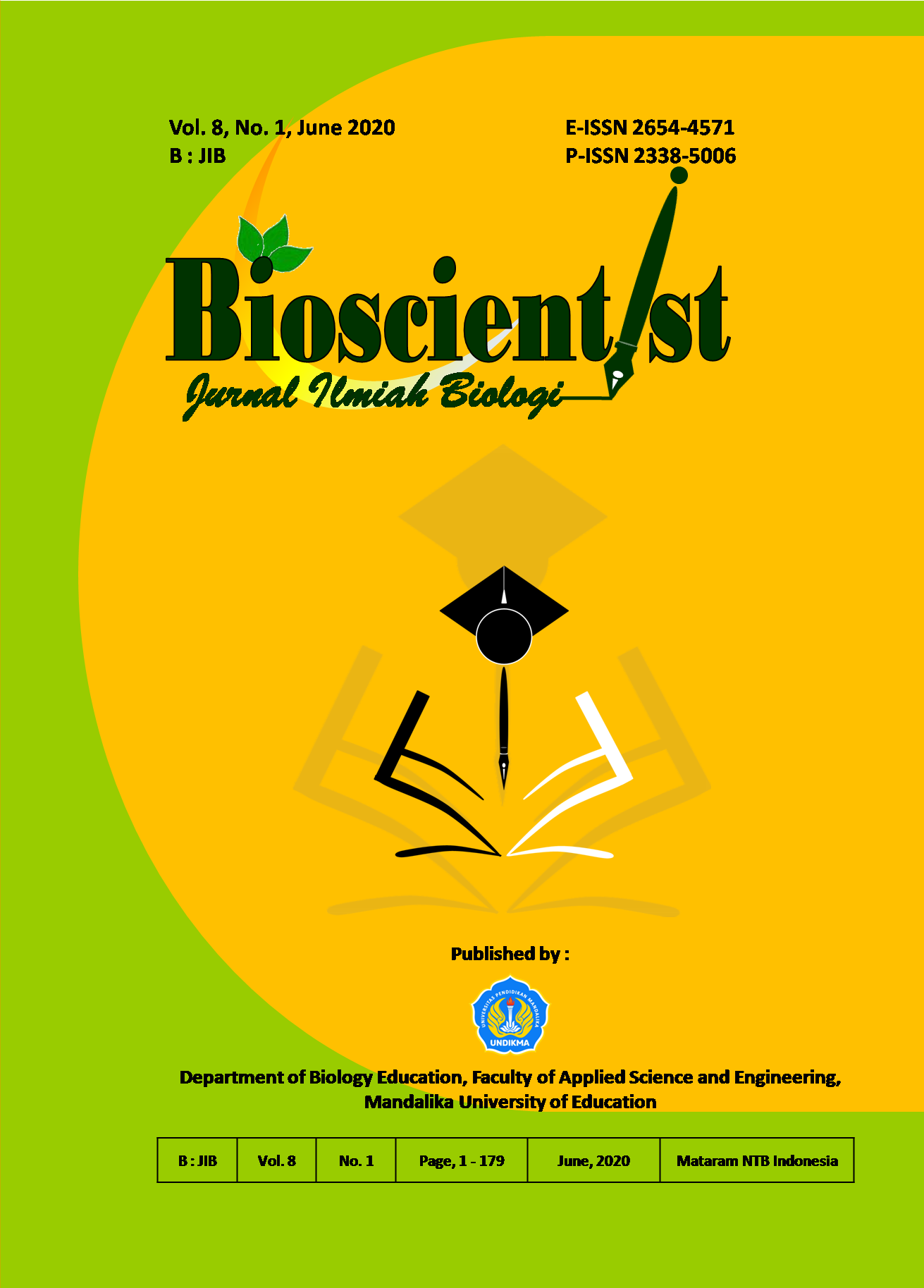PRODUKSI KOKON DAN BIOMASSA CACING TANAH Eisenia foetida PADA BERBAGAI MEDIA BUDIDAYA LIMBAH PETERNAKAN
DOI:
https://doi.org/10.33394/bioscientist.v8i1.2608Keywords:
Biomass, Eisenia foetida, Livestock Waste, Cocoon.Abstract
Livestock waste has a major influence on environmental pollution, if not managed properly, because it will cause a foul odor. Efforts to manage livestock waste have not been successfully carried out completely, so new innovations are needed by utilizing the Eisenia foetida as a reactor to process it into earthworm cultivation medium. Processing of livestock waste with earthworms can produce high economic value cocoon and biomass. To find out the differences in cocoon and biomass production in five types of livestock waste, a research was carried out using a Completely Randomized Design with five treatments and five replications. The results showed that the use of feces of cattle, goats, horses, broiler chickens, and rumen contents as the medium of Eisenia foetida cultivation had a significant effect (P<0.05) on cocoon and biomass production. Duncan's test results showed that the highest cocoon production of 123.0 eggs/nest box obtained on goat feces medium was significantly different (P<0.05) with feces of cattle, horses, chickens and rumen contents. The highest production of earthworm biomass of 1339.0 eggs/nest box obtained in horse feces medium was significantly different (P<0.05) with feces of cattle, goats, chickens, and rumen contents. The conclusion is: 1) to produce the most cocoon using goat feces; 2) to produce the most earthworm biomass using horse feces; 3) to produce the highest weight gain of earthworms using cattle feces; 4) to produce a weight size per head of earthworms using high rumen contents; and 5) the use of feces of broiler chickens is not recommended as a whole (100%) as a medium or feed in livestock waste treatment because it causes all earthworms to die, so they need to be mixed with other medium or feed ingredients.References
Budiarti, A. & Palungkun, R. (2012). Cacing Tanah: Aneka Cara Budidaya, Penanganan Lepas Panen, Peluang Campuran Ransum Ternak dan Ikan. Jakarta: Penebar Swadaya.
Catalan, G. I. (2011). Eathworm a New Recource of Protein. Philippines: Philippine Earthworm Centre.
Dani, I. R., Jarmuji, Pratama, A. W. N., & Nugraha, D. A. (2017). Kolaborasi Messessaba (Media Feses Sapi dan Feses Domba) terhadap Respon Cacing Tanah (Pheretima Sp). Jurnal Sain Peternakan Indonesia, 12(3), 308-316.
Gaddie, R. E. & Douglas, D. E. (2015). Earthworm for Ecology and Profit. California: Bookworm Publishing Campany.
Hanafiah, K. A. (2012). Rancangan Percobaan Teori dan Aplikasi (p. 238). Palembang: Universitas Sriwijaya.
Haukka, J. K. (2017). Growth and Survival of Eisenia foetida (Sav.) (Oligochaeta: Lumbricidae) in Relation to Temperature, Moisture and Presence of Enhytracus albidus (Henle) (Enchytraidae). Biol. Fertil. Soil, 3, 99-102.
Manurung, R., Yusfiati, J., & Roslim, D. I. (2011). Pertumbuhan Cacing Tanah (Perionyx sp.) pada Dua Media. JOM FMIPA, 1(2), 291-302.
Mashur. (2018). Media Terbaik pada Budidaya Cacing Tanah Eisenia Foetida Savigny untuk Menghasilkan Kokon Terbanyak. Journal of Animal Science and Technology, 24(1), 28-38.
______. (2020a). Pemanfaatan Sampah Pasar sebagai Media Budidaya Cacing Tanah Eisenia foetida untuk Meningkatkan Kokon dan Biomassa. Journal Geodika Hamzanwadi, 2(1), 15-25.
______. (2020b). Pemanfaatan Sampah Organik Rumah Tangga sebagai Media Budidaya untuk Meningkatkan Produktivitas Cacing Tanah Eisenia foetida. Journal Sangkareang Mataram, 6(2), 10-19.
Putra, S. E., Johan, I., & Hasby, M. (2018). Pengaruh Pencampuran Kotoran Ternak sebagai Media Kultur terhadap Pertambahan Populasi Cacing Tanah (Lumbricus rubellus). Jurnal Dinamika Pertanian, 34(1), 75-80.
Siallagan, R. (2010). Pengaruh Waktu Tinggal dan Komposisi Bahan Baku pada Proses Fermentasi Limbah Cair Industri Tahu terhadap Produksi Biogas. SSi Skripsi. Universitas Sumatera Utara.
Sihotang, B. (2010). Kandungan Senyawa Kimia pada Pupuk Kandang Berdasarkan Jenis Binatangnya. Retrieved March 29, 2020, from r.yuwie.com/blog/entry.
Simandjuntak, A. K. & Waluyo, D. (2012). Cacing Tanah: Budidaya dan Pemanfaatannya. Jakarta: PT. Penebar Swadaya.
Steel, R. G. D. & Torrie, J. H. (2010). Prinsip dan Prosedur Statistika. Jakarta: Gramedia.
Suharjo, B. (2010). SPSS 7.5 for Windows 8. Bogor: Laboratorium Komputasi Jurusan Matematika FMIPA.
Wahyono, S. (2011). Pengolahan Sampah Organik dan Aspek Sanitasi. Jurnal Teknologi Lingkungan, 2(2), 113-118.
Windyasmara, L., Pertiwiningrum, A., & Yusiati, L. M. (2012). Pengaruh Jenis Kotoran Ternak sebagai Substrat dengan Penambahan Serasah Daun Jati (Tectona grandis) terhadap Karakteristik Biogas pada Proses Fermentasi. Buletin Peternakan, 36(1), 40-47.
Wirosoedarmo, R., Santoso, S. E., & Anugroho, F. (2019). Pengaruh Pemberian Media Berbahan Limbah Kotoran Sapi dan Blotong Tebu terhadap Bobot dan Kadar Protein Cacing African Night Crawler (Eudrilus eugenia). Jurnal Sumberdaya Alam dan Lingkungan, 6(1), 33-40.
Yitnosumarto, S. (2013). Perancangan Percobaan, Analisis, dan Interpretasi. Yogyakarta: Gramedia Pustaka Utama.













